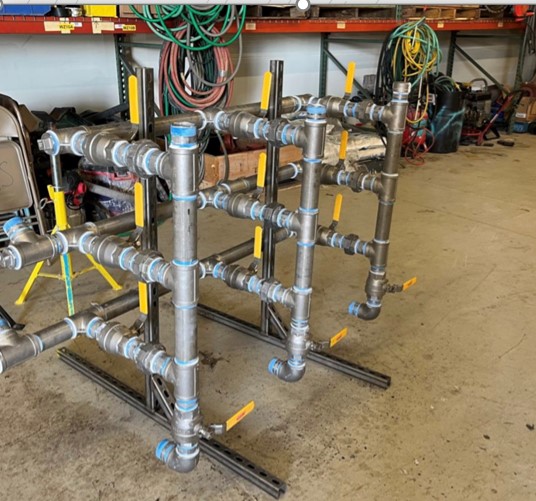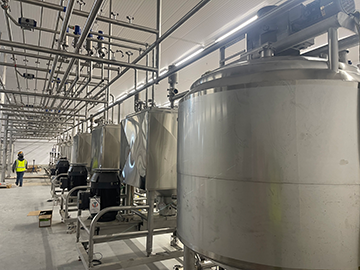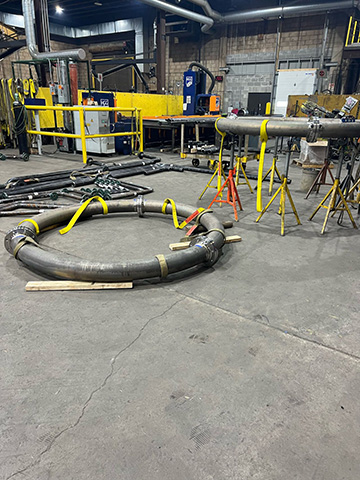If you're trying to find metal for your project that is a common type, has resistance to corrosion, and has outstanding mechanical properties, stainless steel may be a great option to consider. With many great properties, it often provides easier maintenance and strength in corrosive environments. In this post, we'll discuss the benefits and drawbacks of stainless steel, as well as the different grades of stainless steel.

Stainless steel is a type of steel with low carbon content and a very high level of chromium. The various types of stainless steel are often divided by the type of crystalline structure that is formed as the metal cools, including austenitic stainless steels, ferritic stainless steels, duplex, precipitation hardening, and martensitic stainless steel. Generally speaking, austenitic and ferritic stainless steels have better resistance to corrosion.
Austenitic stainless steels make up the bulk of the market. This form of stainless steel has a low yield strength but has a strong heat & corrosion resistance. Applications include food processing, dairy equipment, architecture facades, housewares, industrial piping and vessels, and construction. Austenitic has excellent weldability, good formability, and good market availability.
Ferritic stainless steel generally are without nickel which is commonly used in industrial machinery, automotive parts, and kitchen products. Ferritic is more difficult to produce and it isn’t as good as austenitic for weldability and toughness.
Duplex is a composite of austenitic & ferritic steels. They are traditionally used in industries such as pulp, paper, petrochemical, and shipbuilding.
Martensitic stainless steel that tends to be less corrosion resistant and magnetic because of its low chromium content.
Precipitation hardening stainless steels that contain high percentages of chromium and nickel. It does have higher corrosion resistance and hardness as well as higher strength.
With a minimum of 11% chromium content, stainless steel can include a wide range of other compounds, including nitrogen, silicon, manganese, and nickel content. These other metals provide a variety of benefits to stainless steel, from making it more flexible to providing a better surface finish.
Because of its innate resistance to corrosion, stainless steel is commonly used in damp and corrosive environments, as well as in more common uses such as cutlery, kitchen appliances, and automobiles. Its ability to provide strength without taking on a magnetic field makes it a popular option for newer Magnetic Resonance Imaging (MRI) machines.
The 300 series stainless steel is part of the austenitic family and has nickel content to improve its durability. The 304 grade, which is also known as 18/10 and 18/8 for its 10% and 8% nickel content mixed with 18% to 20% chromium, is the most common type of stainless steel available on the market.
As part of an AISI standard, 304 stainless steel is the most common type of stainless steel containing 18% chromium and between 8% and 10% nickel. It's an austenitic stainless steel, which has a face-centric crystal structure that renders it non-magnetic.

As the most common type of stainless steel that was first patented in 1912, 304 stainless steel has outstanding resistance to corrosion, mechanical properties, and non-magnetic surfaces. It holds up well and is easily cleaned, making it a great choice for industry, healthcare, and commercial kitchens.
By comparison to 304 stainless steel, 316 is the second-most common type of stainless steel. With up to 2% molybdenum content, this steel has additional resistance to corrosion compared to 304 stainless steel. This makes it a tougher option for problematic areas, such as locations that are more likely to be contaminated by acids or areas that are higher in corrosive elements.
Compared to 304 stainless steel, 316 stainless steel has a higher nickel content at 10% to 14% and slightly lower chromium content at 16% to 18%. This makes it a bit tougher overall, and raises the cost. However, much like 304 stainless steel, 316 is simply the number assigned by AISI for that specific type of austenitic stainless steel.
Though it's easy to get hung up on ideas like the best stainless steel, the simple fact is that you need to use the appropriate material for your project. For gas and oil pipelines, as an example, carbon steel may be a better option due to higher flexibility. That being said, 316 stainless has several advantages over 304 stainless in terms of mechanical properties and strength.
As mentioned above, 316 stainless steel has a slightly lower chromium content and higher nickel content, in addition to the 2% molybdenum content that improves its corrosion resistance. By comparison, 304 stainless steel has a lower nickel content and higher chromium content.

Though it's easy to rate one stainless steel over another, it simply depends on your application. For more economical operations, 304 stainless steel is sufficient for most purposes. However, if you're dealing with corrosive environments or acids being used in the area, you may want to spend the extra to upgrade to 316.
Though there are many grades of stainless steel, the metal in general is superior to many on the market. It has better cleanability than copper, brass, or other surfaces common to industry, while being able to better resist corrosion from moisture or acids.
Though stainless steel is resistant to corrosion, that doesn't mean that it can't rust, given the right environment. The passive layer of chromium that forms on the surface of the metal to prevent corrosion is negatively impacted by heat, salt, or electrical currents. This can allow the steel to rust.
As you can see, stainless steel has a lot of properties that make it a great option for many applications. If you need help finding the right stainless steel fittings for your application, the experienced professionals at Merit Brass are ready to help. Please feel free to contact us today with any questions.
FIND THE RIGHT FITTING FOR YOUR APPLICATION
Authors: Authors: Kimberly Wallingford, Director of Marketing and Marcus Estrella, Director of Product Line Management
3/28/2025 1:29:25 PM